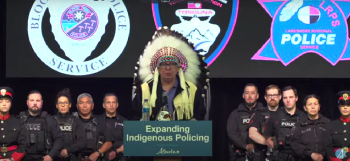Image Caption
Summary
Local Journalism Initiative Reporter
Windspeaker.com
The three First Nations police services in Alberta are lauding the province for providing funding that will allow them to add more officers to their police forces.
Last week, Justice Minister and Solicitor General Tyler Shandro announced that the police services operated by Tsuut’ina and the Blood Tribe in the south, and Lakeshore Regional Police Service in the north, would each receive funding to hire five new members over the next four years.
“This additional work force capacity will ensure that these police services are better positioned than ever to meet the needs of their communities. After all, responsive, engaged, well-funded policing is the right of everyone in our province,” said Shandro.
“I know this is a tough time for police services across the province, Canada, and North America,” said Chief Roy Whitney Onespot of the Tsuut’ina Nation. “From COVID to calls of defunding and ever-changing policies."
But, he said “policing is a core element that makes our society work. Government must first and foremost ensure public safety. That means ensuring that police services are funded adequately and consistently.”
Indigenous police services are usually funded through the First Nations and Inuit Policing Program, with the federal government providing 52 per cent of the cost and the province paying the remaining 48 per cent.
Currently Alberta funds the three First Nations police services annually at $6.4 million, as well as spending more than $500,000 every year to pay for a crime prevention coordinator for each service.
However, for more than two years, the First Nations and Inuit Policing program has been frozen as the federal government reworks it.
First Nations have been lobbying Ottawa to designate First Nation policing as an essential service which would provide consistency in funding, moving it beyond the year-to-year funding agreements.
Tsuut’ina Nation Police Service Chief Keith Blake said Shandro had met with the three First Nations police chiefs to hear their “concerns, our frustrations on the longstanding inequities, the unfair, unjust restrictions that our services face and others do not.”
“(Shandro) recognized these longstanding injustices required immediate and unique supports and that support couldn’t wait until our co-partners in the funding model, the federal government, was there to support (us),” said Blake.
Onespot pointed out that his Nation was in a unique position geographically bordering on Calgary. He said while that proximity provided opportunities, it also provided challenges with the impacts of drugs and violence.
“We face many spillovers (from Calgary). Policing historically has somewhat been a challenge for us and for other First Nations…The relationship between First Nations, Indigenous people and policing authorities has had a checkered past,” said Onespot.
William Wadsworth, chair of the Blood Tribe Police Commission, also welcomed the funding.
“This support is much needed as our communities are growing in numbers, but at the same time as we grow in population, we are experiencing a growing amount of other issues, being drug use and other difficult situations,” he said.
Wadsworth said he was looking forward to continuing the discussions with the province as the Blood Tribe’s police station, built in 1991, needed to be upgraded.
The Lakeshore Regional Police Service has been operating for 14 years and services the five northern First Nations of Sawridge, Swan River, Driftpile, Sucker Creek and Kapaweno.
Dale Cox, chief of the Lakeshore police service, called the chronic underfunding “systemic discrimination.” He said the RCMP received 14 per cent more in funding than the self-administered First Nations police services “and we do exactly the same job.”
The 15-officer complement of the Lakeshore police services, said Driftpile Cree Nation Chief Dwayne Laboucan, who also serves as Grand Chief of Lesser Slave Lake Indian Regional Council, was only half the officers needed to cover the five First Nations, which are spread out geographically. He said the goal of the service was to bring in five officers per year for the next three years. Laboucan added that the funding announced by the province was a start.
Shandro said the province would also be providing $150,000 to address short-term gaps created by the wait for reforms, along with a recruiting strategy for the new officers.
The three First Nations police services currently have a combined 62 members.
Alberta has called on the federal government to expedite its review of the program.
Shandro also announced funding up to $30,000 through the new Community Policing Grant to assist Indigenous and municipal communities in preparing a business case outlining local needs, capital requirements and transition considerations if they “want to explore different policing models.”
Local Journalism Initiative Reporters are supported by a financial contribution made by the Government of Canada.

